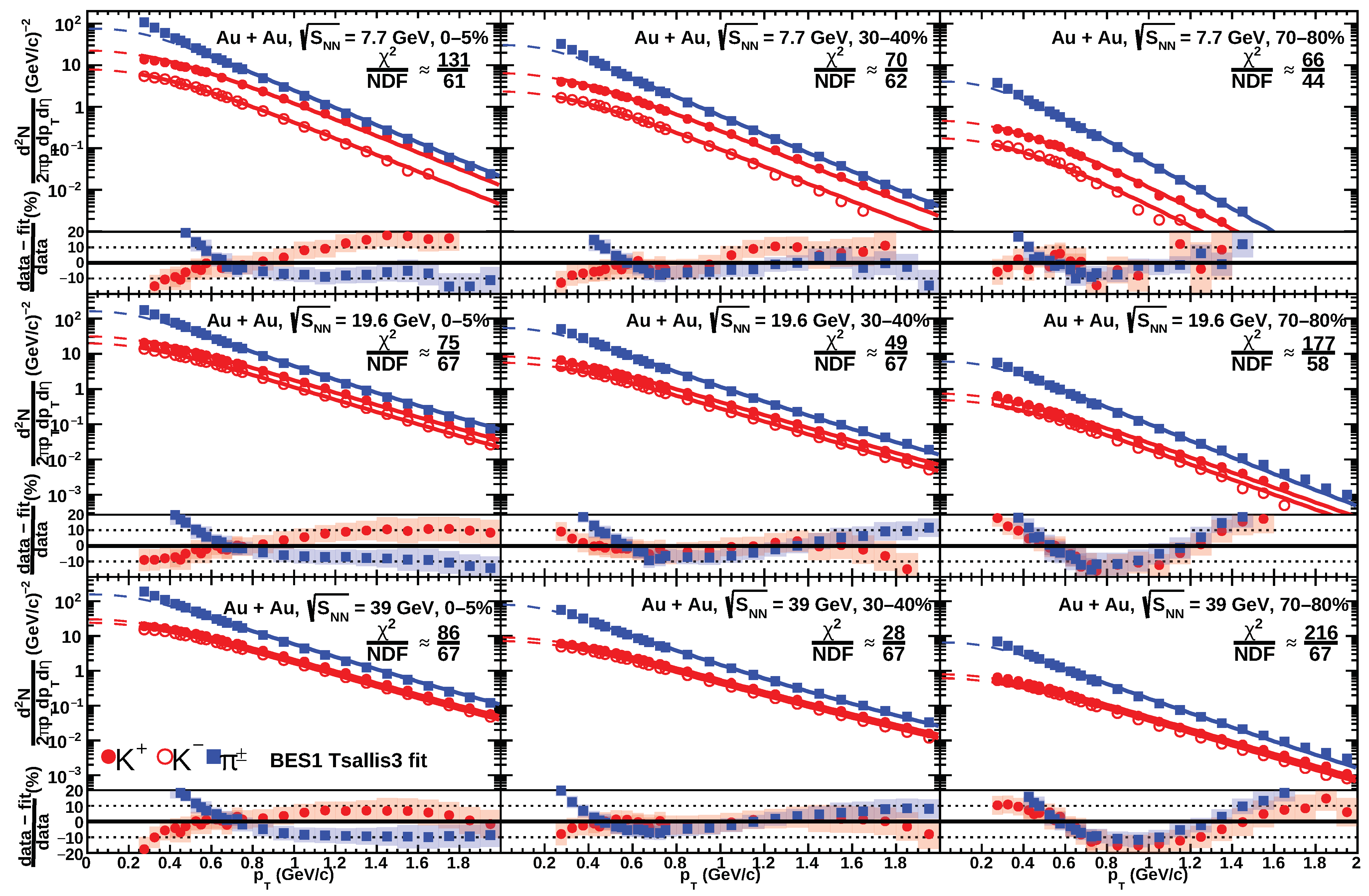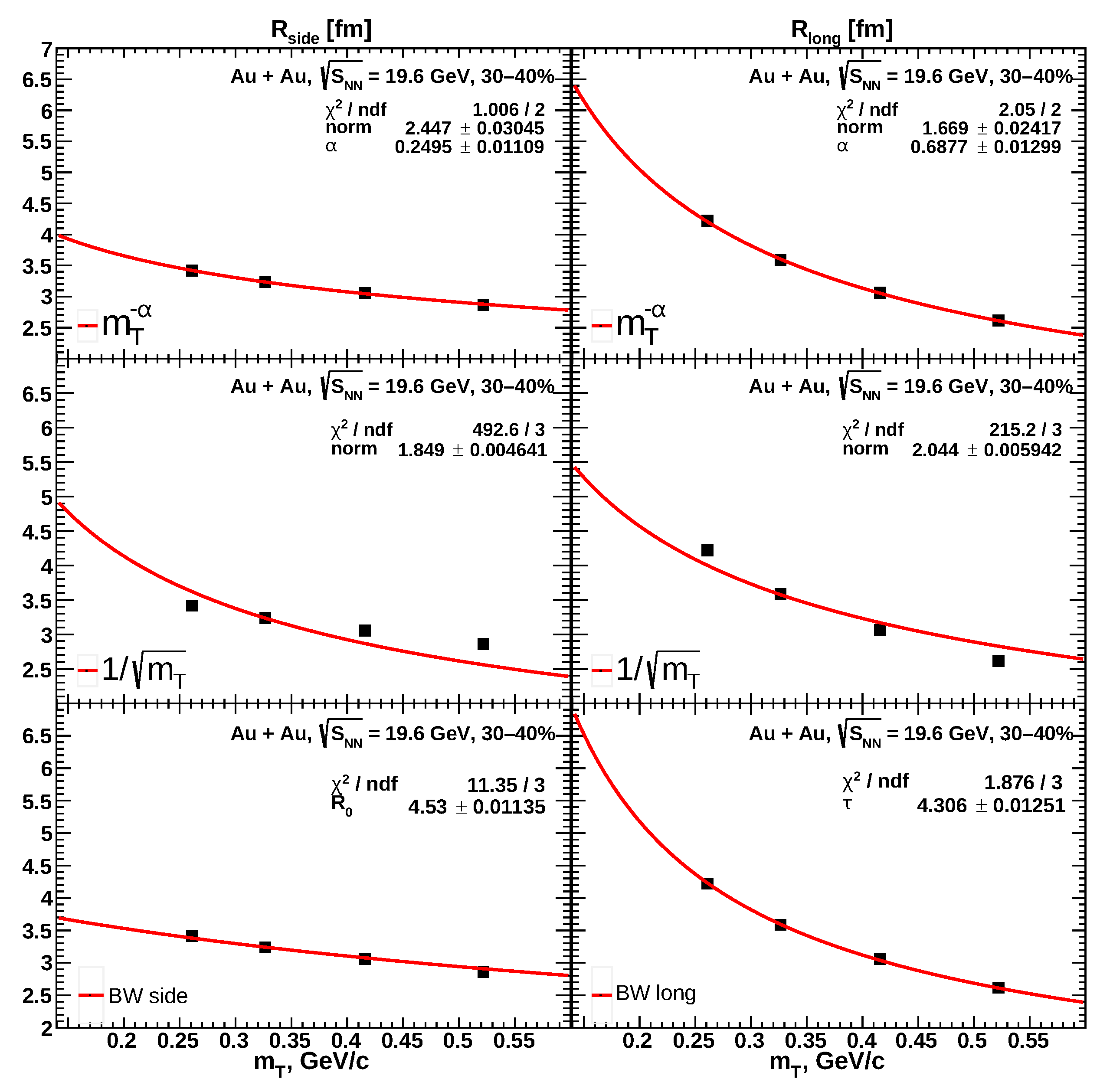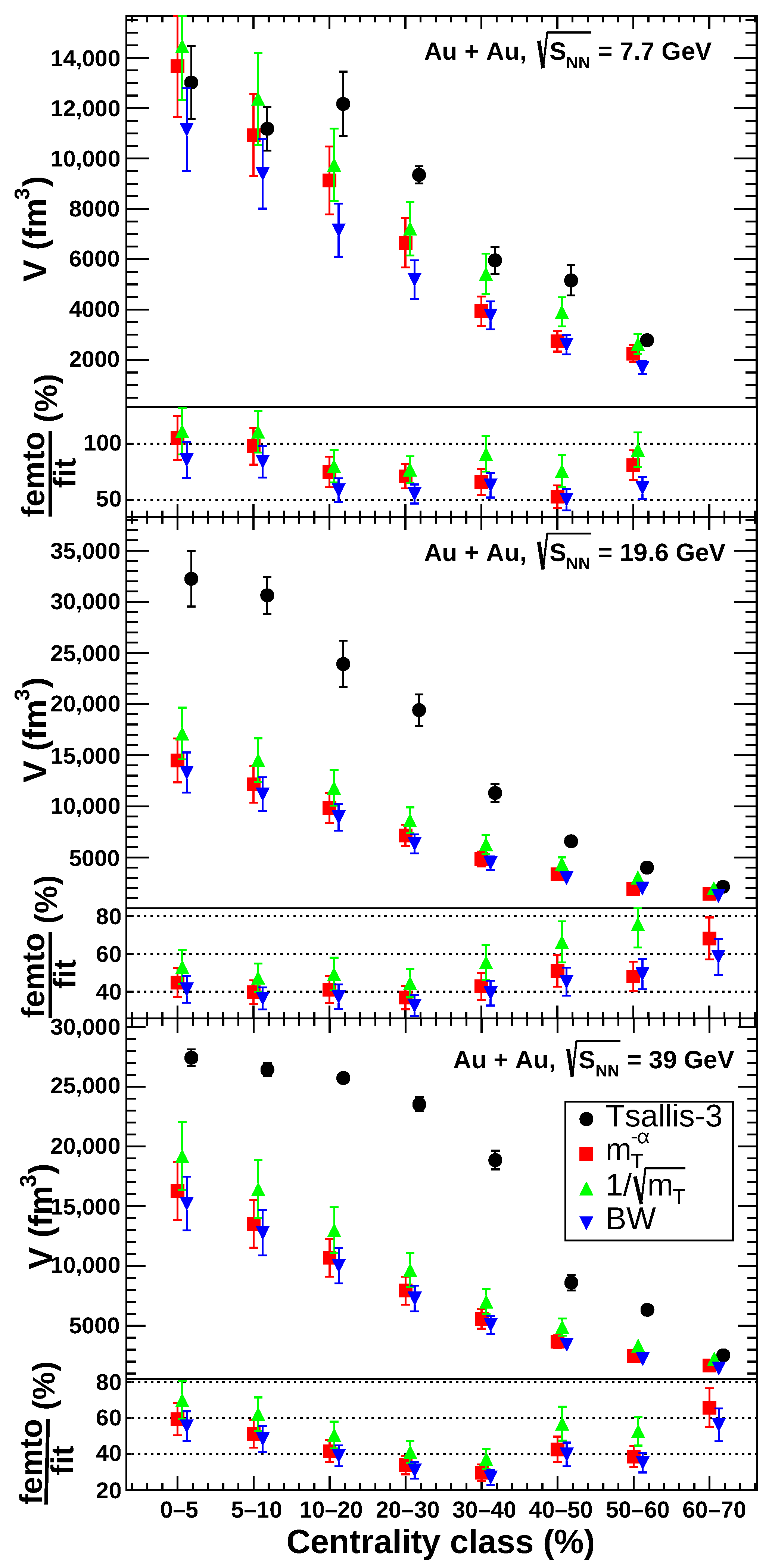A System Size Analysis of the Fireball Produced in Heavy-Ion Collisions †
Abstract
1. Introduction
2. Materials and Methods
2.1. Tsallis-3 Statistics
2.2. Femtoscopic Approach
3. Results and Discussion
- The correlation function may deviate from a Gaussian shape due to exponential tails caused by resonance decay contributions [35]. This can lead to an underestimation of the femtoscopic radii.
- In the Tsallis statistics, the particle interactions and collective effects, including rescattering, are modeled phenomenologically by deformation of entropy using the nonextensive entropic parameter q.
4. Conclusions
Author Contributions
Funding
Data Availability Statement
Acknowledgments
Conflicts of Interest
Appendix A
| Centrality | T (MeV) | q | /NDF |
|---|---|---|---|
| 7.7 GeV | |||
| 0–5% | |||
| 5–10% | |||
| 10–20% | |||
| 20–30% | |||
| 30–40% | |||
| 40–50% | |||
| 50–60% | |||
| 60–70% | |||
| 70–80% | |||
| 11.5 GeV | |||
| 0–5% | |||
| 5–10% | |||
| 10–20% | |||
| 20–30% | |||
| 30–40% | |||
| 40–50% | |||
| 50–60% | |||
| 60–70% | |||
| 70–80% | |||
| 19.6 GeV | |||
| 0–5% | |||
| 5–10% | |||
| 10–20% | |||
| 20–30% | |||
| 30–40% | |||
| 40–50% | |||
| 50–60% | |||
| 60–70% | |||
| 70–80% | |||
| 27 GeV | |||
| 0–5% | |||
| 5–10% | |||
| 10–20% | |||
| 20–30% | |||
| 30–40% | |||
| 40–50% | |||
| 50–60% | |||
| 60–70% | |||
| 70–80% | |||
| 39 GeV | |||
| 0–5% | |||
| 5–10% | |||
| 10–20% | |||
| 20–30% | |||
| 30–40% | |||
| 40–50% | |||
| 50–60% | |||
| 60–70% | |||
| 70–80% | |||
| Centrality | T (MeV) | /NDF | |
|---|---|---|---|
| 7.7 GeV | |||
| 0–5% | |||
| 5–10% | |||
| 10–20% | |||
| 20–30% | |||
| 30–40% | |||
| 40–50% | |||
| 50–60% | |||
| 60–70% | |||
| 70–80% | |||
| 11.5 GeV | |||
| 0–5% | |||
| 5–10% | |||
| 10–20% | |||
| 20–30% | |||
| 30–40% | |||
| 40–50% | |||
| 50–60% | |||
| 60–70% | |||
| 70–80% | |||
| 19.6 GeV | |||
| 0–5% | |||
| 5–10% | |||
| 10–20% | |||
| 20–30% | |||
| 30–40% | |||
| 40–50% | |||
| 50–60% | |||
| 60–70% | |||
| 70–80% | |||
| 27 GeV | |||
| 0–5% | |||
| 5–10% | |||
| 10–20% | |||
| 20–30% | |||
| 30–40% | |||
| 40–50% | |||
| 50–60% | |||
| 60–70% | |||
| 70–80% | |||
| 39 GeV | |||
| 0–5% | |||
| 5–10% | |||
| 10–20% | |||
| 20–30% | |||
| 30–40% | |||
| 40–50% | |||
| 50–60% | |||
| 60–70% | |||
| 70–80% | |||
| Centrality | ||||||
|---|---|---|---|---|---|---|
| 7.7 GeV | ||||||
| 0–5% | ||||||
| 5–10% | ||||||
| 10–20% | ||||||
| 20–30% | ||||||
| 30–40% | ||||||
| 40–50% | ||||||
| 50–60% | ||||||
| 11.5 GeV | ||||||
| 0–5% | ||||||
| 5–10% | ||||||
| 10–20% | ||||||
| 20–30% | ||||||
| 30–40% | ||||||
| 40–50% | ||||||
| 50–60% | ||||||
| 19.6 GeV | ||||||
| 0–5% | ||||||
| 5–10% | ||||||
| 10–20% | ||||||
| 20–30% | ||||||
| 30–40% | ||||||
| 40–50% | ||||||
| 50–60% | ||||||
| 60–70% | ||||||
| 27 GeV | ||||||
| 0–5% | ||||||
| 5–10% | ||||||
| 10–20% | ||||||
| 20–30% | ||||||
| 30–40% | ||||||
| 40–50% | ||||||
| 50–60% | ||||||
| 60–70% | ||||||
| 39 GeV | ||||||
| 0–5% | ||||||
| 5–10% | ||||||
| 10–20% | ||||||
| 20–30% | ||||||
| 30–40% | ||||||
| 40–50% | ||||||
| 50–60% | ||||||
| 60–70% | ||||||
| Centrality | Tsallis-3 | BW | ||
|---|---|---|---|---|
| 7.7 GeV | ||||
| 0–5% | 13,020 | 13,674 | 14,470 | 11,145 |
| 5–10% | 11,184 | 10,931 | 12,370 | |
| 10–20% | ||||
| 20–30% | ||||
| 30–40% | ||||
| 40–50% | ||||
| 50–60% | ||||
| 11.5 GeV | ||||
| 0–5% | ||||
| 5–10% | ||||
| 10–20% | ||||
| 20–30% | ||||
| 30–40% | ||||
| 40–50% | ||||
| 50–60% | ||||
| 19.6 GeV | ||||
| 0–5% | ||||
| 5–10% | ||||
| 10–20% | ||||
| 20–30% | ||||
| 30–40% | ||||
| 40–50% | ||||
| 50–60% | ||||
| 60–70% | ||||
| 27 GeV | ||||
| 0–5% | ||||
| 5–10% | ||||
| 10–20% | ||||
| 20–30% | ||||
| 30–40% | ||||
| 40–50% | ||||
| 50–60% | ||||
| 60–70% | ||||
| 39 GeV | ||||
| 0–5% | ||||
| 5–10% | ||||
| 10–20% | ||||
| 20–30% | ||||
| 30–40% | ||||
| 40–50% | ||||
| 50–60% | ||||
| 60–70% | ||||
References
- BRAHMS Collaboration; Arsene, I.; Bearden, I.G.; Beavis, D.; Besliu, C.; Budick, B.; Bøggild, H.; Chasman, C.; Christensen, C.H.; Christiansen, P.; et al. Quark–gluon plasma and color glass condensate at RHIC? The perspective from the BRAHMS experiment. Nucl. Phys. A 2005, 757, 1–27. [Google Scholar] [CrossRef]
- PHENIX Collaboration; Adcox, K.; Adler, S.S.; Afanasiev, S.; Aidala, C.; Ajitanand, N.N.; Akiba, Y.; Al-Jamel, A.; Alexander, J.; Amirikas, R.; et al. Formation of dense partonic matter in relativistic nucleus-nucleus collisions at RHIC: Experimental evaluation by the PHENIX collaboration. Nucl. Phys. A 2005, 757, 184–283. [Google Scholar] [CrossRef]
- PHOBOS Collaboration; Back, B.B.; Baker, M.D.; Ballintijn, M.; Barton, D.S.; Becker, B.; Betts, R.R.; Bickley, A.A.; Bindel, R.; Budzanowski, A.; et al. The PHOBOS perspective on discoveries at RHIC. Nucl. Phys. A 2005, 757, 28–101. [Google Scholar] [CrossRef]
- STAR Collaboration; Adams, J.; Aggarwal, M.M.; Ahammed, Z.; Amonett, J.; Anderson, B.D.; Arkhipkin, D.; Averichev, G.S.; Badyal, S.K.; Bai, Y.; et al. Experimental and theoretical challenges in the search for the quark-gluon plasma: The STAR collaboration’s critical assessment of the evidence from RHIC collisions. Nucl. Phys. A 2005, 757, 102–183. [Google Scholar] [CrossRef]
- Aoki, Y.; Endrodi, G.; Fodor, Z.; Katz, S.D.; Szabo, K.K. The Order of the quantum chromodynamics transition predicted by the standard model of particle physics. Nature 2006, 443, 675–678. [Google Scholar] [CrossRef]
- Bazavov, A.; Ding, H.T.; Hegde, P.; Kaczmarek, O.; Karsch, F.; Karthik, N.; Laermann, E.; Lahiri, A.; Larsen, R.; Li, S.-T.; et al. Chiral crossover in QCD at zero and non-zero chemical potentials. Phys. Lett. B 2019, 795, 15–21. [Google Scholar] [CrossRef]
- Adamczyk, L.; Adkins, J.K.; Agakishiev, G.; Aggarwal, M.M.; Ahammed, Z.; Ajitanand, N.N.; Alekseev, I.; Anderson, D.M.; Aoyama, R.; Aparin, A.; et al. Bulk properties of the medium produced in relativistic heavy-ion collisions from the beam energy scan program. Phys. Rev. C 2017, 96, 044904. [Google Scholar] [CrossRef]
- Adamczyk, L.; Adkins, J.K.; Agakishiev, G.; Aggarwal, M.M.; Ahammed, Z.; Alekseev, I.; Alford, J.; Anson, C.D.; Aparin, A. Beam-energy-dependent two-pion interferometry and the freeze-out eccentricity of pions measured in heavy ion collisions at the STAR detector. Phys. Rev. C 2015, 92, 014904. [Google Scholar] [CrossRef]
- Tsallis, C. Possible generalization of Boltzmann-Gibbs statistics. J. Statist. Phys. 1988, 52, 479–487. [Google Scholar] [CrossRef]
- Tsallis, C.; Mendes, R.S.; Plastino, A.R. The role of constraints within generalized nonextensive statistics. Phys. A 1998, 261, 534–554. [Google Scholar] [CrossRef]
- Parvan, A.S. Hadron transverse momentum distributions in the Tsallis statistics with escort probabilities. J. Phys. G Nucl. Part. Phys. 2023, 50, 125002. [Google Scholar] [CrossRef]
- Brown, R.H.; Twiss, R.Q. A Test of a New Type of Stellar Interferometer on Sirius. Nature 1956, 178, 1046–1048. [Google Scholar] [CrossRef]
- Goldhaber, G.; Goldhaber, S.; Lee, W.; Pais, A. Influence of Bose-Einstein Statistics on the Antiproton-Proton Annihilation Process. Phys. Rev. 1960, 120, 300. [Google Scholar] [CrossRef]
- Kopylov, G.I.; Podgoretsky, M.I. Correlations of identical particles emitted by highly excited nuclei. Sov. J. Nucl. Phys. 1972, 15, 219–223. [Google Scholar]
- Lednicky, R.; Lyuboshits, V.L. Final State Interaction Effect on Pairing Correlations Between Particles with Small Relative Momenta. Sov. J. Nucl. Phys. 1982, 15, 770. [Google Scholar]
- Kaufman, S.; Ashktorab, K.; Beavis, D.; Chasman, C.; Chen, Z.; Chu, Y.Y.; Cumming, J.B.; Debbe, R.; Gonin, M.; Gushue, S.; et al. System, centrality, and transverse mass dependence of two-pion correlation radii in heavy ion collisions at 11.6A and 14.6A GeV/c. Phys. Rev. C 2002, 66, 549061–5490615. [Google Scholar]
- Bearden, I.G.; Bøggild, H.; Boissevain, J.; Dodd, J.; Erazmus, B.; Esumi, S.; Fabjan, C.W.; Ferenc, D.; Fields, D.E.; Franz, A.; et al. High energy Pb+Pb collisions viewed by pion interferometry. Phys. Rev. C 1998, 58, 1656. [Google Scholar] [CrossRef]
- Adams, J.; Aggarwal, M.M.; Ahammed, Z.; Amonett, J.; Anderson, B.D.; Arkhipkin, D.; Averichev, G.S.; Badyal, S.K.; Bai, Y.; Balewski, J.; et al. Pion interferometry in Au+Au collisions at =200 GeV. Phys. Rev. C 2005, 71, 044906. [Google Scholar] [CrossRef]
- Aamodt, K.; Quintana, A.A.; Adamová, D.; Adare, A.M.; Aggarwal, M.M.; Rinella, G.A.; Rinella, G.A.; Agocs, A.G.; Salazar, S.A.; Ahammed, Z.; et al. Two-pion Bose–Einstein correlations in central Pb–Pb collisions at =2.76 TeV. Phys. Lett. B 2011, 696, 328–337. [Google Scholar] [CrossRef]
- Hatlo, M.; James, F.; Mato, P.; Moneta, L.; Winkler, M.; Zsenei, A. Developments of mathematical software libraries for the LHC experiments. IEEE Trans. Nucl. Sci. 2005, 52, 2818–2822. [Google Scholar] [CrossRef]
- Lisa, M.; Pratt, S.; Soltz, R.; Wiedemann, U. Femtoscopy in Relativistic Heavy Ion Collisions: Two Decades of Progress. Ann. Rev. Nucl. Part. Sci. 2005, 55, 357–402. [Google Scholar] [CrossRef]
- Pratt, S. Pion interferometry of quark-gluon plasma. Phys. Rev. D 1986, 33, 1314. [Google Scholar] [CrossRef]
- Bertsch, G.; Gong, M.; Tohyama, M. Pion interferometry in ultrarelativistic heavy-ion collisions. Phys. Rev. C 1988, 37, 1896. [Google Scholar] [CrossRef] [PubMed]
- Sinyukov, Y.M.; Lednicky, R.; Akkelin, S.V.; Pluta, J.; Erazmus, B. Coulomb corrections for interferometry analysis of expanding hadron systems. Phys. Lett. B 1998, 432, 248–257. [Google Scholar] [CrossRef]
- Bowler, M.G. Coulomb corrections to Bose-Einstein corrections have greatly exaggerated. Phys. Lett. B 1991, 270, 69–74. [Google Scholar] [CrossRef]
- Wiedemann, U.A.; Heinz, U. Particle interferometry for relativistic heavy-ion collisions. Phys. Rept. 1999, 319, 150–230. [Google Scholar] [CrossRef]
- Makhlin, A.N.; Sinyukov, Y.M. Hydrodynamics of Hadron Matter Under Pion Interferometric Microscope. Z. Phys. C 1988, 39, 69. [Google Scholar] [CrossRef]
- Wiedemann, U.A.; Scotto, P.; Heinz, U. Transverse momentum dependence of Hanbury-Brown–Twiss correlation radii. Phys. Rev. C 1996, 53, 918. [Google Scholar] [CrossRef]
- Schnedermann, E.; Sollfrank, J.; Heinz, U. Thermal phenomenology of hadrons from 200A GeV S+S collisions. Phys. Rev. C 1993, 48, 2462. [Google Scholar] [CrossRef]
- Retière, F.; Lisa, M.A. Observable implications of geometrical and dynamical aspects of freeze-out in heavy ion collisions. Phys. Rev. C 2004, 70, 044907. [Google Scholar] [CrossRef]
- Heinz, U.W.; Tomasik, B.; Wiedemann, U.A.; Wu, Y.F. Lifetimes and sizes from two-particle correlation functions. Phys. Lett. B 1996, 382, 181. [Google Scholar] [CrossRef]
- Nedorezov, E.V.; Parvan, A.S.; Aparin, A.A. Description of Charged Particle Dependence on Transverse Momentum with Tsallis-Like Distribution. Phys. Part. Nucl. 2024, 55, 984–989. [Google Scholar] [CrossRef]
- Parvan, A.S. Equivalence of the phenomenological Tsallis distribution to the transverse momentum distribution of q-dual statistics. Eur. Phys. J. A 2020, 56, 106. [Google Scholar] [CrossRef]
- Sinyukov, Y.M. Spectra and correlations in locally equilibrium hadron and quark-gluon systems. Nucl. Phys. A 1994, 566, 589–592. [Google Scholar] [CrossRef]
- Shapoval, V.M.; Sinyukov, Y.M.; Karpenko, I.A. Emission source functions in heavy ion collisions. Phys. Rev. C 2013, 88, 064904. [Google Scholar] [CrossRef]



Disclaimer/Publisher’s Note: The statements, opinions and data contained in all publications are solely those of the individual author(s) and contributor(s) and not of MDPI and/or the editor(s). MDPI and/or the editor(s) disclaim responsibility for any injury to people or property resulting from any ideas, methods, instructions or products referred to in the content. |
© 2025 by the authors. Licensee MDPI, Basel, Switzerland. This article is an open access article distributed under the terms and conditions of the Creative Commons Attribution (CC BY) license (https://creativecommons.org/licenses/by/4.0/).
Share and Cite
Nedorezov, E.; Aparin, A.; Parvan, A.; Luong, V.B. A System Size Analysis of the Fireball Produced in Heavy-Ion Collisions. Particles 2025, 8, 34. https://doi.org/10.3390/particles8010034
Nedorezov E, Aparin A, Parvan A, Luong VB. A System Size Analysis of the Fireball Produced in Heavy-Ion Collisions. Particles. 2025; 8(1):34. https://doi.org/10.3390/particles8010034
Chicago/Turabian StyleNedorezov, Egor, Alexey Aparin, Alexandru Parvan, and Vinh Ba Luong. 2025. "A System Size Analysis of the Fireball Produced in Heavy-Ion Collisions" Particles 8, no. 1: 34. https://doi.org/10.3390/particles8010034
APA StyleNedorezov, E., Aparin, A., Parvan, A., & Luong, V. B. (2025). A System Size Analysis of the Fireball Produced in Heavy-Ion Collisions. Particles, 8(1), 34. https://doi.org/10.3390/particles8010034









